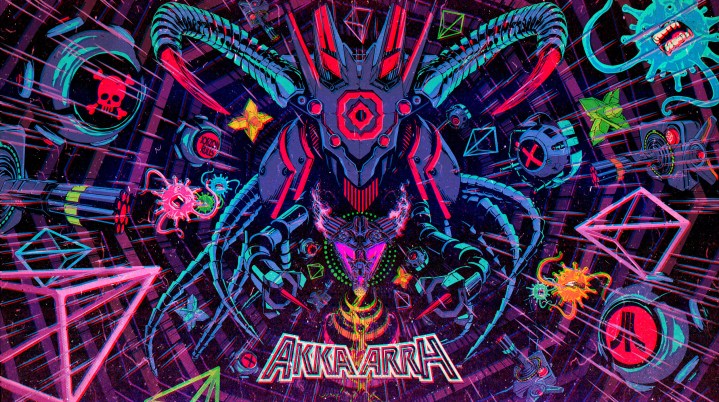
You know that it’s a busy year for gaming when a project by an industry legend launches with hardly any fanfare. That’s exactly what happened in February 2023 with Akka Arrh. Created by Jeff Minter and his eccentric studio Llamasoft, the neon-tinted shooter is a remake of a 1982 Atari game that never saw the light of day after being deemed too difficult. Minter got the greenlight to revive the project, bringing it to life as a retro arcade shooter built in his unmistakable style.
While the project was exciting for game historians, it didn’t exactly crack into the mainstream (it only has 37 user reviews on Steam). Thankfully, Akka Arrh getting a second chance to shine this week as its new PlayStation 5 version adds PlayStation VR2 support. While that might not be enough to make it a commercial hit, it does give PSVR2 owners a good reason to dust off their headset and check out a delightfully oddball project from one of gaming’s true visionaries.
It’s a trip
Akka Arrh is the rare example of a game that might be easier to explain on paper than in practice. In this throwback arcade shooter, players control a stationary ship that’s tasked with protecting pods from attacking aliens. To fend off foes, players drop bombs that blow up in a different geometric pattern on each level’s map. Every time an enemy touches that blast radius, it blows up in the same pattern, chaining to other enemies. The goal is to keep an uninterrupted chain going as long as possible by using a limited number of bullets to knock out foes that can’t be destroyed by bombs and grabbing power-ups by hovering the cursor over them.
Like a lot of Llamasoft’s games, Akka Arrh is rule-bending title that can be a lot to take in. It features an overwhelming retro art style, full of flashing neon lights and stray particles. While its gameplay sounds easy enough on paper, its made more complex with mounting systems that pile on through its 50 levels. Its chaotic UI is a mess of numbers, gameplay prompts, and gags (when I get a big combo, a bit of text at the top tells me I’ve achieved a “Jesus and Mary Chain”). This is all to say, its a Jeff Minter game.

That’s not a knock against it, though Akka Arrh will make a lot more sense to anyone who is familiar with Llamasoft’s prolific output. It neatly fits into the lineage of classic Minter games, from the genre experimentation of Gridrunner and Tempest 2000 to the trippy light spectacle of Colourspace. Its most notable parallel is with 1986’s Iridis Alpha, a Commodore 64 shooter that had players managing two separate screens. That idea is revisited here. When enemies reach the ship, they dip down into a lower layer and start stealing pods. Players can jump down to that screen at any time to shoot them off, juggling two hectic tasks at once.
When I first played Akka Arrh in 2023, I was downright baffled by it. I didn’t have as firm an understanding of Minter’s style as I do now, leading me to some frustrating play sessions where I struggled to grasp the basics. Like many of Minter’s games, though, that initial confusion is part of the charm. The more determined you are to understand it, the more its satisfying loop reveals itself. On this revisit, I found the chill joys of setting off massive chains and watching enemies blow up in rhythmic fashion.
The experience is ever so slightly enhanced by the PS5 version’s VR support. The extra layer of immersion gives it the same appeal as Tetris Effect and Fantavision 202X, putting players in a psychedelic headspace that makes it easier to focus on chains. It’s like I’m both crafting and watching a light show, a concept Minter has long been fascinated with. VR brings that idea to life even more as text and particles zoom toward me. It’s a trip, the kind that only Minter knows how to make this well.

That’s not to say that VR support entirely wipes away the things that initially frustrated me about Akka Arrh. It can still be a struggle to read the screen with its mess of text and colors. I still find myself hitting levels where I can’t figure out how to drop a bomb or what part of the screen is bombable at all. The absurd chaos is very much the point, as it is in Minter cult classics like Mama Llama, but it can still make the learning curve feel insurmountable to a newcomer.
Stick with it, though, and you’ll find an occasionally therapeutic arcade shooter that’s sure to fire off some endorphins. There’s retro joy to be found the more you learn to navigate the chaos and go with its flow. The best way to experience that is through a VR headset, which blocks out the real world and transports you directly into Minter’s eccentric brain.
Akka Arrh comes to PlayStation 5 with PSVR2 support on March 8. You can also learn more about Minter’s work in Llamasoft: The Jeff Minter Story, an interactive documentary from Digital Eclipse that launches on March 13.



